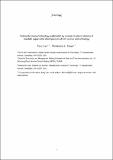| dc.contributor.author | Han, Fang | |
| dc.contributor.author | Magee, Christopher L | |
| dc.date.accessioned | 2021-09-20T17:20:18Z | |
| dc.date.available | 2021-09-20T17:20:18Z | |
| dc.date.issued | 2018-05-19 | |
| dc.identifier.uri | https://hdl.handle.net/1721.1/131540 | |
| dc.description.abstract | Abstract
The relationship of scientific knowledge development to technological development is widely recognized as one of the most important and complex aspects of technological evolution. This paper adds to our understanding of the relationship through use of a more rigorous structure for differentiating among technologies based upon technological domains (defined as consisting of the artifacts over time that fulfill a specific generic function using a specific body of technical knowledge). The key findings of the work are: Firstly, a Pearson correlation of 0.564 is found between technological relatedness among technological domains based upon patents citing other patents and technological relatedness among technological domains based upon patents citing similar scientific papers. This result indicates that a large portion of technological relatedness is due to relatedness of the underlying scientific categories. Secondly, the overall structure of the links found between scientific categories and technological domains is many-to-many rather than focused indicating a science-fostered mechanism for fairly broad “spillover”: Specific technological domains cite a wide variety of scientific categories; some scientific categories are cited in a variety of domains. Thirdly, some evidence is found supporting the co-evolution of science and technology but the evidence is not strong. Prior research that identifies emerging patent clusters and independent prior research identifying emerging scientific topics show statistically significant but qualitatively weak inter-relationships between the clusters and topics. This work also offers evidence that patent cluster emergence can, but does not usually, precede the emergence of related scientific topics. The lack of clear evidence for co-evolution is interpreted as resulting from the documented complex many-to-many relationship of science categories and technological domains and is not considered evidence against co-evolution. | en_US |
| dc.publisher | Springer International Publishing | en_US |
| dc.relation.isversionof | https://doi.org/10.1007/s11192-018-2774-y | en_US |
| dc.rights | Article is made available in accordance with the publisher's policy and may be subject to US copyright law. Please refer to the publisher's site for terms of use. | en_US |
| dc.source | Springer International Publishing | en_US |
| dc.title | Testing the science/technology relationship by analysis of patent citations of scientific papers after decomposition of both science and technology | en_US |
| dc.type | Article | en_US |
| dc.contributor.department | SUTD-MIT International Design Centre (IDC) | |
| dc.contributor.department | Massachusetts Institute of Technology. Institute for Data, Systems, and Society | |
| dc.eprint.version | Author's final manuscript | en_US |
| dc.type.uri | http://purl.org/eprint/type/JournalArticle | en_US |
| eprint.status | http://purl.org/eprint/status/PeerReviewed | en_US |
| dc.date.updated | 2020-09-24T21:14:51Z | |
| dc.language.rfc3066 | en | |
| dc.rights.holder | Akadémiai Kiadó, Budapest, Hungary | |
| dspace.embargo.terms | Y | |
| dspace.date.submission | 2020-09-24T21:14:51Z | |
| mit.license | PUBLISHER_POLICY | |
| mit.metadata.status | Authority Work and Publication Information Needed | |
